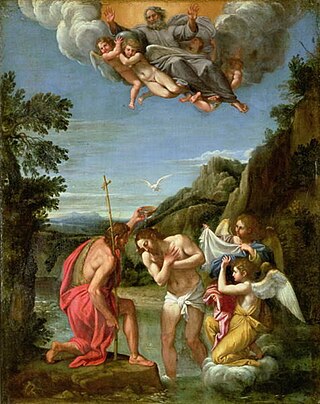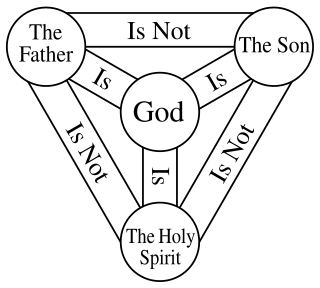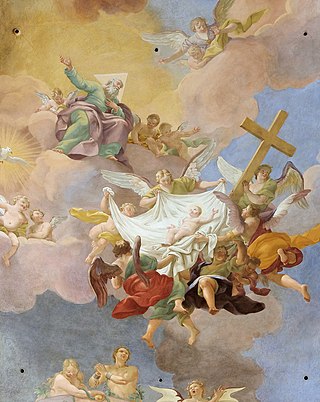
Adoptionism, also called dynamic monarchianism, is an early Christian nontrinitarian theological doctrine, subsequently revived in various forms, which holds that Jesus was adopted as the Son of God at his baptism, his resurrection, or his ascension. How common adoptionist views were among early Christians is debated, but it appears to have been most popular in the first, second, and third centuries. Some scholars see adoptionism as the belief of the earliest followers of Jesus, based on the epistles of Paul and other early literature. However, adoptionist views sharply declined in prominence in the fourth and fifth centuries, as Church leaders condemned it as a heresy.

In Christianity, Christology, translated from Greek as 'the study of Christ', is a branch of theology that concerns Jesus. Different denominations have different opinions on questions such as whether Jesus was human, divine, or both, and as a messiah what his role would be in the freeing of the Jewish people from foreign rulers or in the prophesied Kingdom of God, and in the salvation from what would otherwise be the consequences of sin.

Historically, many rulers have assumed titles such as the son of God, the son of a god or the son of heaven.

The Christian doctrine of the Trinity is the central doctrine concerning the nature of God in most Christian churches, which defines one God existing in three coequal, coeternal, consubstantial divine persons: God the Father, God the Son and God the Holy Spirit, three distinct persons (hypostases) sharing one essence/substance/nature (homoousion). As the Fourth Lateran Council declared, it is the Father who begets, the Son who is begotten, and the Holy Spirit who proceeds. In this context, one essence/nature defines what God is, while the three persons define who God is. This expresses at once their distinction and their indissoluble unity. Thus, the entire process of creation and grace is viewed as a single shared action of the three divine persons, in which each person manifests the attributes unique to them in the Trinity, thereby proving that everything comes "from the Father," "through the Son," and "in the Holy Spirit."
Chalcedonian Christianity is a term referring to the branches of Christianity that accept and uphold theological resolutions of the Council of Chalcedon, the fourth ecumenical council, held in 451. Chalcedonian Christianity accepts the Christological Definition of Chalcedon, a Christian doctrine concerning the union of two natures in one hypostasis of Jesus Christ, who is thus acknowledged as a single person (prosopon). Chalcedonian Christianity also accepts the Chalcedonian confirmation of the Niceno-Constantinopolitan Creed, thus acknowledging the commitment of Chalcedonism to Nicene Christianity.
Incarnation literally means embodied in flesh or taking on flesh. It refers to the conception and the embodiment of a deity or spirit in some earthly form or the appearance of a god as a human. If capitalized, it is the union of divinity with humanity in Jesus Christ. In its religious context the word is used to mean a god, deity, or divine being in human or animal form on Earth.
In Christian theology, divinization, or theopoesis or theosis, is the transforming effect of divine grace, the spirit of God, or the atonement of Christ. Although it literally means to become divine, or to become God, most modern Christian denominations do not interpret the doctrine as implying an overcoming of a fundamental ontological difference between God and humanity; for example, John of the Cross indicated that while "God communicates to it [the individual soul] His supernatural Being, in such wise that it appears to be God Himself, and has all that God Himself has", yet "it is true that its natural being, though thus transformed, is as distinct from the Being of God as it was before".

Theophany is an encounter with a deity, in which it manifests in an observable and tangible form. Where the deity does not take tangible form, the broader term used for inward manifestation is divine revelation or divine inspiration. Where the god indwells in a human person, the terms used are divine incarnation, an avatar, or, poetically, the personification of that deity. Theophanies, tangible appearances of a god, are distinguished from epiphanies, which are powerful internal changes in outlook caused by a theophany or other divine revelation.
Communicatio idiomatum is a Christological concept about the interaction of deity and humanity in the person of Jesus Christ. It maintains that in view of the unity of Christ's person, his human and divine attributes and experiences might properly be referred to his other nature so that the theologian may speak of "the suffering of God".
The gender of God can be viewed as a literal or as an allegorical aspect of a deity.

In Christianity, the Logos is a name or title of Jesus Christ, seen as the pre-existent second person of the Trinity. In the Douay–Rheims, King James, New International, and other versions of the Bible, the first verse of the Gospel of John reads:
In the beginning was the Word, and the Word was with God, and the Word was God.
Prosopon is a theological term used in Christian theology as designation for the concept of a divine person. The term has a particular significance in Christian Triadology, and also in Christology.

Haḍra is a collective supererogatory ritual performed by Sufi orders. It is often held on Thursday evenings after the night prayer, on Fridays after jumu'ah prayer or on Sunday evenings, and can also be celebrated on special Islamic festivals and at rites of passage. It may be held at home, in a mosque. The underlying term in Arabic literally means "Divine Presence" and the human experience of it is known as "Hudur".
This is a glossary of terms used in Christianity.

The pre-existence of Christ asserts the existence of Christ prior to his incarnation as Jesus. One of the relevant Bible passages is John 1:1–18 where, in the Trinitarian interpretation, Christ is identified with a pre-existent divine hypostasis called the Logos. There are nontrinitarian views that question the aspect of personal pre-existence, the aspect of divinity, or both.

The Myth of God Incarnate is a book edited by John Hick and published by SCM Press in 1977. James Dunn, in a 1980 literature review of academic work on the incarnation, noted the "...well-publicized symposium entitled The Myth of God Incarnate, including contributions on the NT from M. Goulder and F. Young, which provoked several responses." Two years later, in another literature review, R. T. France commented that "theology dropped out of the headlines again, until in 1977 the title, if not the contents, of The Myth of God Incarnate revived public interest". In the 21st century, The Daily Telegraph 2005 obituary for contributor Maurice Wiles described the book as "a highly controversial volume of essays." The controversy prompted a sequel, Incarnation and Myth: the Debate Continued (1979), edited by Michael Goulder, another contributor to the original volume.
Christian theology is the theology – the systematic study of the divine and religion – of Christian belief and practice. It concentrates primarily upon the texts of the Old Testament and of the New Testament, as well as on Christian tradition. Christian theologians use biblical exegesis, rational analysis and argument. Theologians may undertake the study of Christian theology for a variety of reasons, such as in order to:

Christian theology sometimes refers to Jesus using the title Redeemer. This refererences the salvation he accomplished, and is based on the metaphor of redemption, or "buying back". In the New Testament, redemption can refer both to deliverance from sin and to freedom from captivity.

The Last Adam, also given as the Final Adam or the UltimateAdam, is a title given to Jesus in the New Testament. Similar titles that also refer to Jesus include Second Adam and New Adam.

Christology: A Biblical, Historical, and Systematic Study of Jesus is a 2009 theological book by the Australian Jesuit priest and academic Gerald O'Collins. This work was originally published in 1995 with the title Christology: A Biblical, Historical, and Systematic Study of Jesus Christ, but the author thoroughly revised the whole text in 2009 to take account of the numerous biblical, historical, and systematic studies of Jesus that appeared following its first edition.











